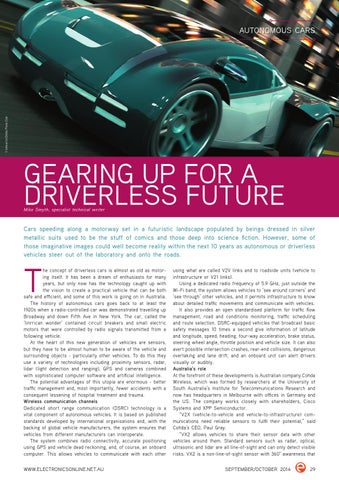© oliman1st/Dollar Photo Club
AUTONOMOUS CARS
GEARING UP FOR A DRIVERLESS FUTURE Mike Smyth, specialist technical writer
Cars speeding along a motorway set in a futuristic landscape populated by beings dressed in silver metallic suits used to be the stuff of comics and those deep into science fiction. However, some of those imaginative images could well become reality within the next 10 years as autonomous or driverless vehicles steer out of the laboratory and onto the roads.
T
he concept of driverless cars is almost as old as motoring itself. It has been a dream of enthusiasts for many years, but only now has the technology caught up with the vision to create a practical vehicle that can be both safe and efficient, and some of this work is going on in Australia. The history of autonomous cars goes back to at least the 1920s when a radio-controlled car was demonstrated travelling up Broadway and down Fifth Ave in New York. The car, called the ‘linrrican wonder’ contained circuit breakers and small electric motors that were controlled by radio signals transmitted from a following vehicle. At the heart of this new generation of vehicles are sensors, but they have to be almost human to be aware of the vehicle and surrounding objects - particularly other vehicles. To do this they use a variety of technologies including proximity sensors, radar, lidar (light detection and ranging), GPS and cameras combined with sophisticated computer software and artificial intelligence. The potential advantages of this utopia are enormous - better traffic management and, most importantly, fewer accidents with a consequent lessening of hospital treatment and trauma. Wireless communication channels Dedicated short range communication (DSRC) technology is a vital component of autonomous vehicles. It is based on published standards developed by international organisations and, with the backing of global vehicle manufacturers, the system ensures that vehicles from different manufacturers can interoperate. The system combines radio connectivity, accurate positioning using GPS and vehicle dead reckoning, and, of course, an onboard computer. This allows vehicles to communicate with each other
WWW.ELECTRONICSONLINE.NET.AU
using what are called V2V links and to roadside units (vehicle to infrastructure or V21 links). Using a dedicated radio frequency of 5.9 GHz, just outside the Wi-Fi band, the system allows vehicles to ‘see around corners’ and ‘see through’ other vehicles, and it permits infrastructure to know about detailed traffic movements and communicate with vehicles. It also provides an open standardised platform for traffic flow management, road and conditions monitoring, traffic scheduling and route selection. DSRC-equipped vehicles that broadcast basic safety messages 10 times a second give information of latitude and longitude, speed, heading, four-way acceleration, brake status, steering wheel angle, throttle position and vehicle size. It can also avert possible intersection crashes, rear-end collisions, dangerous overtaking and lane drift, and an onboard unit can alert drivers visually or audibly. Australia’s role At the forefront of these developments is Australian company Cohda Wireless, which was formed by researchers at the University of South Australia’s Institute for Telecommunications Research and now has headquarters in Melbourne with offices in Germany and the US. The company works closely with shareholders, Cisco Systems and XPP Semiconductor. “V2X (vehicle-to-vehicle and vehicle-to-infrastructure) communications need reliable sensors to fulfil their potential,” said Cohda’s CEO, Paul Gray. “VX2 allows vehicles to share their sensor data with other vehicles around them. Standard sensors such as radar, optical, ultrasonic and lidar are all line-of-sight and can only detect visible risks. VX2 is a non-line-of-sight sensor with 360° awareness that
SEPTEMBER/OCTOBER 2014
29
